If you want to stretch your paychecks by making your work truck last as long as possible, you can overbuild it for hauling and towing. Sure, you can check the box next to the towing package options if you’re buying a brand-new truck, but that doesn’t mean you have to stop there. You can improve on the manufacturer’s setup, or even build your own trailer package from scratch.
Those of you who bought a used work truck didn’t get to choose the options installed at the factory or dealership, but that shouldn’t stop you from upgrading your vehicle to maximize its towing and hauling ability. This can help prevent you from ending up on the side of the road with a blown engine, busted transmission, broken differential, or exchanging driver’s license and insurance info with the victim of a work truck that gets out of control.
Whether you plan on using your work truck for towing every single day, only once in a while, or just to lug heavy loads in the bed, there is a lot you can do to enhance safety, reduce wear, and even improve fuel economy. Here are some ideas to help you optimize your hauling and towing capability while ensuring your work truck will last as long as possible
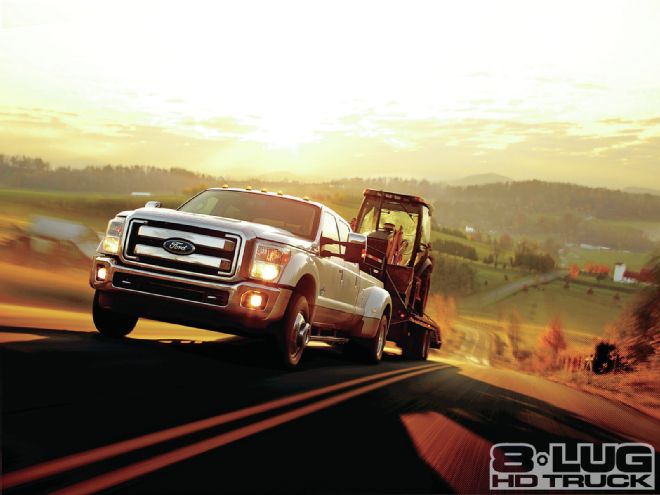
| tow Like A Boss Tow Kit Upgrade ford Truck Towing
The Hookup
Before you make plans to upgrade your work truck for towing or hauling big loads, you need to first know the limits of your pickup as determined by the manufacturer. Even if you make every upgrade listed in this article, the manufacturer ratings should not be exceeded, because they take into account factors such as the strength of the frame, load ratings of the axles and wheel bearings, the steering system, and other extremely important parts. Failure can put the lives of you, your passengers, and other drivers at risk.
Once you know your limits, you’ll need to figure out which type of hitch will be most effective for your towing needs. The Big Three are currently offering traditional frame-mounted hitches with a Class V, 2½-inch- diameter ball mount that can be used to tow up to 18,000 pounds with the use of weight distribution systems. These receivers can also accept smaller-sized ball mounts with the use of an adapter sleeve, which will reduce the amount of weight that can be towed but will allow you to hook up to trailers with smaller ball receivers. If your HD work truck does not have a trailer hitch, you’ll probably want to add at least a Class V that attaches directly to the frame, because it will give you plenty of secure capability and the most flexibility for attaching it to various sizes of trailers 18,000 pounds or less.
For towing agricultural or industrial trailers, a gooseneck ball hitch mounted in the bed may be best for you. It moves the trailer mounting point from the back of the pickup box to a very stable location between the rear wheels. In addition to the added towing capacity, a gooseneck hitch takes up very little cargo space in the bed, and underbed or “hidden” gooseneck trailer balls can even be flipped upside-down or retracted into the pickup box when not in use. A gooseneck can be rated to tow up to 30,000 pounds, which is well beyond the federal limit set at 26,001 pounds maximum gross combined weight rating (GCWR), which is the weight of the pickup and trailer added together. Without a commercial driver’s license (CDL), getting caught exceeding the 26,000-pound GCWR limit can lead to fines with five digits after the dollar sign.

| The Ford Super Duty can be ordered with a gooseneck or fifth-wheel hitch, an adjustable trailer brake system, and accessories designed for towing (above), but you can also build up your own work truck and transform it into a towing beast. A Class V hitch, such as this Reese model, attaches directly to the frame and can allow you to tow up to 18,000 pounds while leaving space for storage in your pickup bed.
For towing a camper, vehicle transporter, or other heavy trailer, you can also use a fifth-wheel hitch mounted between the back wheels, which may also be rated up to 30,000 pounds. Much like a semitruck, a fifth-wheel uses a circular flat plate that locks a trailer’s kingpin to the center while still allowing it to pivot. These hitches take up a lot more space than a gooseneck, but they can offer more security in the connection between work truck and trailer, and some models even offer a gooseneck ball hitch so you can have multiple towing options.
Once you’ve decided which type of hitch is best for your work and/or play, you’ll need an electrical connection between your pickup and the trailer to operate the turn signals, brake lamps, and—most importantly—the trailer brakes themselves. For this, you’ll need a seven-pin wiring harness. If your truck is not already equipped with one, you’ll need to install one. If your truck has a four-pin connector, you’d be best off with a seven-pin harness, but you can get a four-pin-to-seven-pin adapter to make sure you’ll be in better command of the trailer behind your truck.

| A gooseneck hitch attaches to your work truck’s frame underneath the floor of the bed and can be rated to tow as much as 30,000 pounds.
Take Control
Now that you have the required wiring, you can put it to good use by installing a trailer brake controller module. This assures your truck and trailer coordinate braking so the amount of stopping power is applied proportionally. Though they were once available only from aftermarket vendors, new HD trucks can be ordered with an integrated controller built into the dash. While aftermarket units have numerous adjustable features, one advantage to the factory-installed units is the advent of electronic trailer sway control, which adds the super-fast stability control functions of your pickup to the trailer behind it (although stability control is often only offered on single-rear-wheel work trucks).
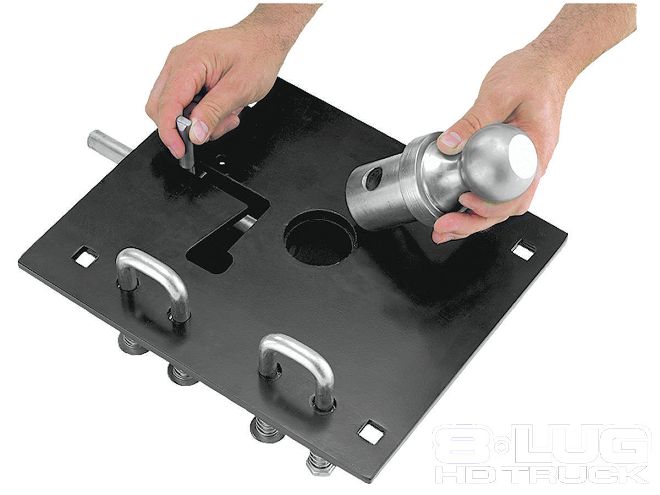
| The Draw-Tite Remov-A-Ball gooseneck hitch allows you to pop out the trailer ball when it’s not being used to maximize your bed capacity.
This can also be achieved with the use of mechanical sway controllers, which try to prevent sway before it happens. The factory electronic systems actively monitor the state of the pickup and trailer and can apply the brakes and/or reduce the throttle thousands of times per second to keep the trailer in line with the pickup while preventing trailer wheel lockups.
For conventional under-bumper hitches, you need to invest in a trailer weight distribution system. These setups use bars and chains, which reduce the strain of the trailer’s weight at the trailer ball hitch (referred to as the tongue weight) by more evenly distributing the pressure so the hitch ball is not the only support point for the trailer connection. In addition to a weight distribution system, you’ll definitely not want to skimp on the sway control add-ons.
Another way to ensure the stability of your towing setup is to upgrade your front and rear springs. The factories currently offer these types of upgrades as a towing option, but like the other upgrades mentioned in this article, you may want to go above and beyond what you can get through a dealership. In addition to adding stiffer front springs, you can add a leaf to the rear springs and/or add auxiliary leafs to the rear axle to keep your work truck more stable while towing. You can also install a rear stabilizer bar to the rear suspension (or a larger one if your pickup is already equipped with one) to keep the back axle settled when it’s under the full load of a trailer.

| This Bulldog Fold-Down gooseneck is a hide-away hitch that folds flat into the bed when not in use.
If you’re willing to open your wallet wide and give up the cushy ride of an independent suspension, many experienced towers will insist it’s worth the cost to put a solid axle under the front end of your work truck for towing purposes. By adding a straight axle in place of the factory setup, you can add weight to the front of the truck to increase balance and assure the front tires are planted on the road when you are towing a heavy trailer.
One feature commonly required for ordering a factory tow package is a limited-slip/locking rear differential, which adds traction and stability by making sure your work truck will not “peg leg” and spin a tire on only one side when traction becomes an issue. This is a relatively low-cost upgrade, which can make a major difference in the capability of your tow vehicle.
Power Up
After you have prepped your HD work truck for the rigors of towing, you can start increasing the power and durability of the powertrain. Just like hot-rodders, you can increase the horsepower and torque of your engine with the addition of a high-flow intake and engine computer unit (ECU) programmer—especially if your work truck is equipped with a diesel engine. Diesel engines can easily gain 100 hp and 200 lb-ft of torque with just some computer trickery, but gas-powered HD work trucks can also gain significant power increases with the addition of a cold-air intake, ECU upgrades, aftermarket injectors, and a larger exhaust system.
You can also free your engine of the restrictions of emissions equipment such as the exhaust gas recirculation (EGR) system, catalytic converter, diesel particulate filter, and even a urea injection system, but we highly discourage you from making any of these modifications, because they are illegal on a federal level, they cause more pollution, and California is just the first state to begin smog-testing diesel work trucks—with the requirement that all factory emissions equipment remains intact. For better or worse, the rest of the country has historically followed California’s lead in emissions regulations, so you might as well be prepared for your state to start smog-testing diesels, and those emissions parts are definitely not cheap to replace.

| This Reese 22K fifth-wheel hitch is rated to tow up to 22,000 pounds with your trailer locked in place. It’s the same brand Ford chose for its fifth-wheel package, and Reese even sells the 30K, a commercial model capable of lugging 30,000 pounds, which requires a CDL.
To make sure the power increases do not grenade your drivetrain, your next step should be to increase the capability of the transmission. One way to improve the durability and efficiency of an automatic transmission is by upgrading the torque converter. For even more capacity and durability, you can invest in a full HD transmission upgrade. Even without replacing any mechanical parts, you can upgrade an automatic transmission by adding an electronic transmission controller. Much like the Tow/Haul button on modern transmission shifter stalks (but with more features), a transmission controller will optimize the transmission shift points, alter the operation of the torque converter, and change many other settings, such as the amount of grade braking.
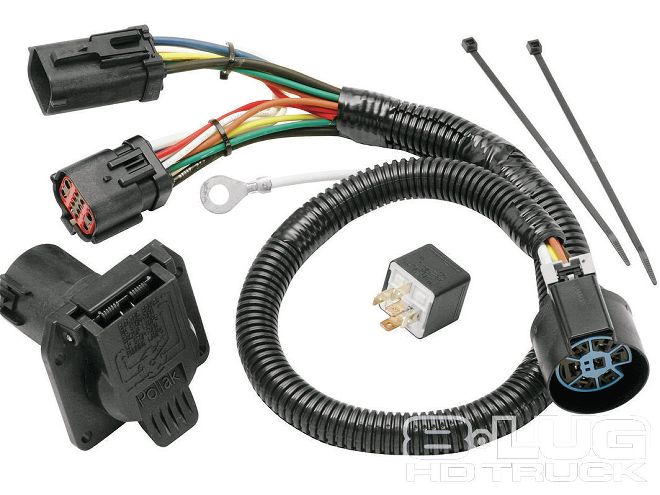
| Hidden Hitch makes a factory replacement seven-pin wiring harness you can install so you can have the best control over your trailer setup.
Keep It Cool
If you decide to increase the power of the big diesel or gasoline engine of your HD work truck, you’ll definitely need to help it breathe both in and out. In fact, there’s not much use upgrading the ECU for more power if the engine can’t ingest enough air or expel the exhaust it creates. The easiest way to feed your engine the amount of air it needs is to yank out the restrictive factory intake in favor of a high-flow aftermarket cold-air intake.
The colder the air, the more dense it will be, which means more oxygen to optimize the fuel entering the cylinders. For diesel engines, a larger-than-stock intercooler will significantly improve the density of the air intake before it is compressed, and therefore heated by the compression of the turbocharger. Both gasoline and diesel engines will benefit by running cooler with the use of a more efficient aftermarket radiator, electric pusher fans, and an auxiliary engine oil cooler. Even an extra-deep oil pan with built-in cooling fins will help your engine be as efficient and powerful as possible, with the added bonus of extending its life.

| Now all the Big Three work truck manufacturers offer integrated trailer brake controllers, such as this one built into the dash of Chevy/GMC HD pickups.
Being cool is not just about making power; it’s about keeping your drivetrain alive, because excess heat is a known killer. Getting the exhaust out of your engine is very important, and the best way to do that is to increase the ability of the engine to push heat out through the exhaust system by making it flow as freely as possible. For gasoline engines, you can use all the tricks favored by muscle car builders, such as replacing the exhaust manifolds with equal-length headers wrapped in heat insulation material or the more expensive versions coated with ceramic or other materials that keep the hot gases inside the exhaust until it’s routed away from the engine.
For diesel and gas engines, the bigger the exhaust system, the easier it will be for the burned fuel vapors to escape. The only limitation you will have is keeping the government-mandated emissions equipment in place for the reasons mentioned earlier in the article. That doesn’t mean you have to restrict your system to the same size as the stock factory tubes, though. You can dramatically increase the diameter of your exhaust pipes before and after the emissions parts, which will still increase flow while keeping your truck legal. This will also keep your exhaust system cooler and make sure you don’t overheat your gas engine or melt your diesel’s turbo. Exceeding 1,200 degrees of diesel exhaust temperature can equal death for the compressor and send hot metal straight into the engine when the turbo fins break off, so you’ll definitely need an exhaust temperature gauge for towing.

| A trailer weight distribution such as the Reese Straight-Line can help you balance up to 1,700 pounds of tongue weight by dispensing the heft of the trailer connection so the trailer ball is not the only weight-bearing part.
One of the biggest victims of heat can be your transmission, which is put under great stress while you are towing. Like the engine, you can protect this expensive piece of equipment with an auxiliary fluid cooler and a deeper oil pan with ventilation ribs. To make sure you keep your transmission out of the danger zone (anything around or exceeding 250 degrees), you should install a transmission temperature gauge or use an engine programmer that displays this information. Just a few minutes of towing with a transmission at 300 degrees can lead to instant disaster and cause the clutch plates to turn into mush, leaving you stranded and in need of a complete rebuild.
Parts that are also susceptible to the excess heat of towing are the axle differentials. The preventative measure to avoid this problem is relatively inexpensive. By adding fin-equipped aftermarket covers to the diff pumpkins at the center of the axles, you can have more room for oil to keep the gears cool, and the fins will add more surface area to help heat escape.
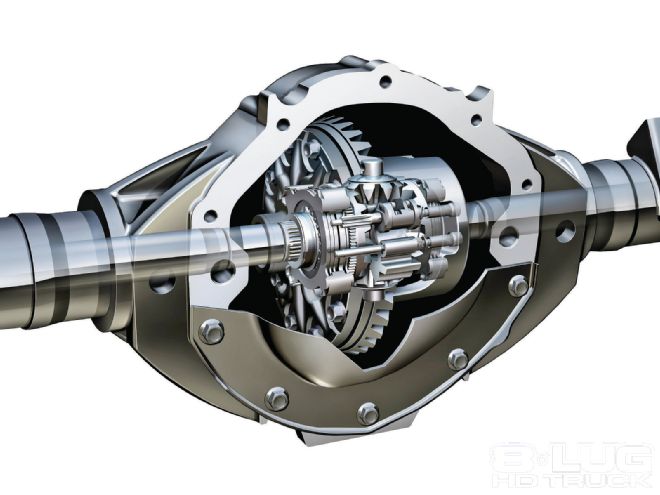
| tow Like A Boss Tow Kit Upgrade internal View Of Differential
Slow Your Roll
In addition to using the transmission gearing to slow your work truck and trailer combination on downgrades, more slowing power that doesn’t heat-soak your wheel brakes is always a plus. Even though most modern work trucks have large, four-wheel disc brakes—which are close to or larger than 14 inches in diameter as standard equipment—you can still upgrade the rotors and the pads. Aftermarket companies offer drilled and slotted rotors (such as those found on sports cars), which are designed to dissipate heat quickly, so you can avoid the dreaded soft pedal of doom and potential warping of the factory discs.

| Mechanical trailer sway parts reduce the amount of lateral motion to help prevent fishtailing, or worse, a jackknife accident.
Companies also offer high-quality brake pads made from special composites to reduce wear and prevent the buildup of heat. Aftermarket brake upgrades are also available for trailers so you can have the strongest, most consistent stopping power available at every wheel in your pickup and trailer combination. If your work truck is equipped with a diesel engine and does not have a factory exhaust brake built into the turbo setup, you should definitely consider adding one, because it will dramatically increase your stopping power by using the engine compression to assist your brakes.
Watch It!
While the factories offer everything from giant two-section towing mirrors to power-extending mirrors, which stretch out to give you a full view of your trailer, your work truck may only be equipped with standard mirrors that aren’t sufficient. That doesn’t mean you should settle for poor visibility. In addition to aftermarket towing mirrors, you may be able to scavenge some power-extending trailer mirrors from a junked work truck.

| The Big Three HD work truck manufacturers offer locking and/or limited-slip rear differentials. The GM G80 axle seen here is a mechanical unit that works like a limited-slip up to a certain difference in wheelspin on the driver and passenger sides, which then triggers it to lock. The Ford differential shown is an electronic locker, while Ram trucks employ a more conventional limited-slip design.
You can also get a factory-installed rear backup sensor or a camera system on modern HD trucks, but these features are also available from the aftermarket, and some even include larger monitors than what you can get from the factory option list. Another safety feature that’s available from the factory but is readily available from the aftermarket at a low cost is a backup beeper that’s activated when you put your pickup into reverse, to make sure no one wanders into the way of 20,000-plus pounds of truck and trailer while you are busy maneuvering your massive machine.
Never Too Safe
Even with all the proper equipment installed on your work truck for safe trailer towing, you should be ready for the unexpected. Just in case your trailer accidentally gets disconnected from your pickup, you should have a trailer breakaway kit installed. This will apply the trailer brakes and bring it to a stop to prevent the nightmare of seeing your trailer pass you on the highway or disappear in your rearview mirrors on its way to causing a major accident.

| Programmers such as the Banks Power iQ can display all the most important towing information you will need, such as the temperature of the transmission, engine, and exhaust, along with the fuel and turbo boost pressures.
By installing a trailer hitch lock and safety chains, you can help prevent this type of emergency along with helping avoid burglary while you are parked. Another anti-theft accessory you should consider adding is an aftermarket alarm with a motion sensor. While factory alarms will go off if someone manages to get a door open, a motion-activated alarm should recognize theft attempts before it’s too late, and some systems even include a remote control, which works like a pager and will immediately alert you to which section of your truck is being tampered with.
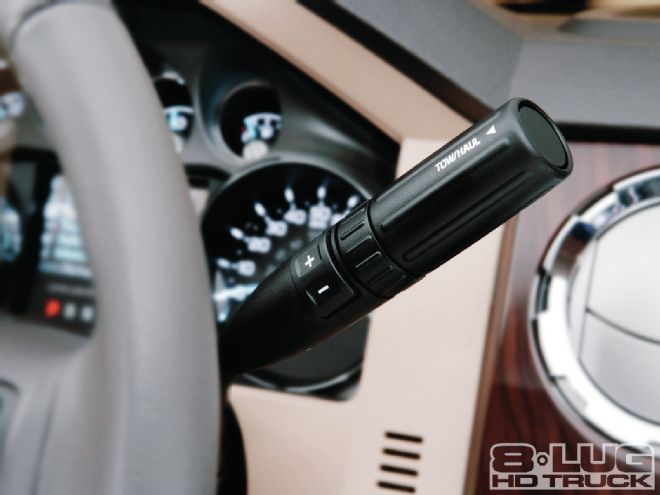
| Factory-equipped Tow/Haul functions are often standard equipment on modern HD trucks, but dedicated transmission programmers and ECU/Transmission units can give you even more control of your HD work truck’s automatic tranny.
Maximize MPG and Range
As you’ve probably realized by now, transforming your HD work truck into a towing monster can be expensive, but you may be able to recover some of those costs by improving your fuel economy. The most straightforward way to improve your miles per gallon is by installing axle gears that are numerically low. While 4.10:1 gears provide great power amplification and a kick in the pants at low rpm, the extreme horsepower and torque that’s standard with today’s gasoline- and diesel-powered engines is usually more than enough for smaller axle gears. Even 3.73:1 ratio gears may be more than you need while traveling at highway speeds. In other words, if you can install gears that give you the confidence to get your towing done but require less rpm for each turn of the wheels, you will save money on fuel.

| MBRP’s Cool Duals catalytic-back exhaust system for diesel trucks is an example of how you can increase power while lowering your EGT, without removing federally mandated emissions controls. Extra-large exhaust systems can also be applied to gasoline-powered HD work trucks to improve performance and fuel economy.
Along with drive axle gearing, some companies can even add an extra overdrive gear to a factory automatic transmission. This modification is currently being offered for early models of the Allison transmission used in Chevy and GMC HD trucks, which now come standard with six-speeds. Other transmission modifications mentioned earlier in the article, such as electronic shift control and torque converter upgrades, can minimize driveline losses, which improve fuel economy. Also, most engine programmers include a Tow/Economy setting, which claims to improve fuel economy by as much as 3 mpg for diesel models.
Other ways to maximize your fuel efficiency may involve you removing parts from your current work truck setup. By replacing knobby, off-road tires in favor of high-load-rating, all-season street tires, you can significantly reduce rolling resistance for big gains in fuel economy along with added stability on paved roads.
Even with increased mpg, towing will use up a lot more fuel than an HD truck under no extra load. To make sure you can take advantage of cheap fuel stations and assure you have enough fuel to make it to your destination, an auxiliary fuel tank is a good idea. Luckily, you have lots of options, from a traditional underbody tank to an in-bed toolbox/fuel tank combination.

| Modern Ford Super Duty trucks can be factory equipped with the sophisticated Productivity Screen, which allows drivers to store information about trailer brake settings for specific trailers and tell the ECU which type of trailer connection you are using, such as a conventional hitch, gooseneck, or fifth-wheel.
That’s not to say all add-ons are detrimental to fuel economy. While it may seem superfluous, an extended plastic valence under the front bumper can do wonders for fuel economy by directing airflow away from the maze of drivetrain parts below the wind-tunnel-tested body of your work truck. You can also add a bedcover if you will be towing with a rear-mounted hitch. If it won’t prevent you from getting to your job site, you can even lower your truck a bit to help it minimize wind resistance. No, you don’t need to turn your work truck into a lowrider, but every inch can make a big difference as long as it doesn’t compromise your load-carrying ability.
Now You Can Tow Like a Pro
By adding some, if not all, the upgrades mentioned in this article, you should be able to turn a new truck or even a used HD pickup into a towing beast. You can expect more capacity, better safety, and a longer life out of your work truck, which will help you get the most out of your investments for years to come.
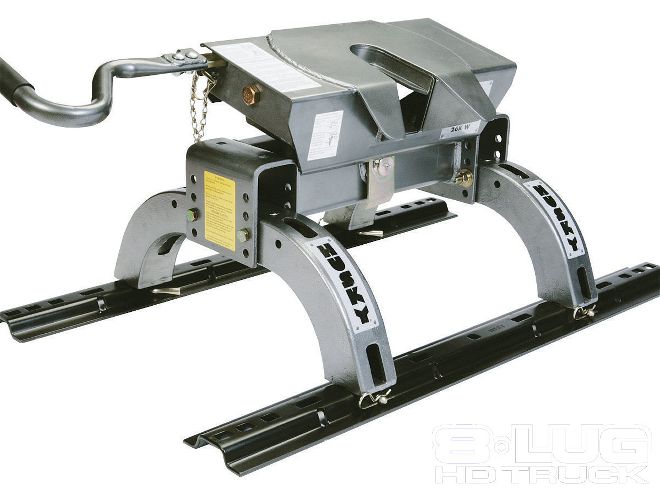
| This 26K fifth-wheel hitch from Husky Towing Products is fully articulating to make off-camber entrances and driveway aprons a breeze to get into.
 | tow Like A Boss Tow Kit Upgrade ford Truck Towing
The Hookup
| tow Like A Boss Tow Kit Upgrade ford Truck Towing
The Hookup | The Draw-Tite Remov-A-Ball gooseneck hitch allows you to pop out the trailer ball when it’s not being used to maximize your bed capacity.
This can also be achieved with the use of mechanical sway controllers, which try to prevent sway before it happens. The factory electronic systems actively monitor the state of the pickup and trailer and can apply the brakes and/or reduce the throttle thousands of times per second to keep the trailer in line with the pickup while preventing trailer wheel lockups.
| The Draw-Tite Remov-A-Ball gooseneck hitch allows you to pop out the trailer ball when it’s not being used to maximize your bed capacity.
This can also be achieved with the use of mechanical sway controllers, which try to prevent sway before it happens. The factory electronic systems actively monitor the state of the pickup and trailer and can apply the brakes and/or reduce the throttle thousands of times per second to keep the trailer in line with the pickup while preventing trailer wheel lockups. | Hidden Hitch makes a factory replacement seven-pin wiring harness you can install so you can have the best control over your trailer setup.
Keep It Cool
| Hidden Hitch makes a factory replacement seven-pin wiring harness you can install so you can have the best control over your trailer setup.
Keep It Cool | tow Like A Boss Tow Kit Upgrade internal View Of Differential
Slow Your Roll
| tow Like A Boss Tow Kit Upgrade internal View Of Differential
Slow Your Roll | Factory-equipped Tow/Haul functions are often standard equipment on modern HD trucks, but dedicated transmission programmers and ECU/Transmission units can give you even more control of your HD work truck’s automatic tranny.
Maximize MPG and Range
| Factory-equipped Tow/Haul functions are often standard equipment on modern HD trucks, but dedicated transmission programmers and ECU/Transmission units can give you even more control of your HD work truck’s automatic tranny.
Maximize MPG and Range | This 26K fifth-wheel hitch from Husky Towing Products is fully articulating to make off-camber entrances and driveway aprons a breeze to get into.
| This 26K fifth-wheel hitch from Husky Towing Products is fully articulating to make off-camber entrances and driveway aprons a breeze to get into.